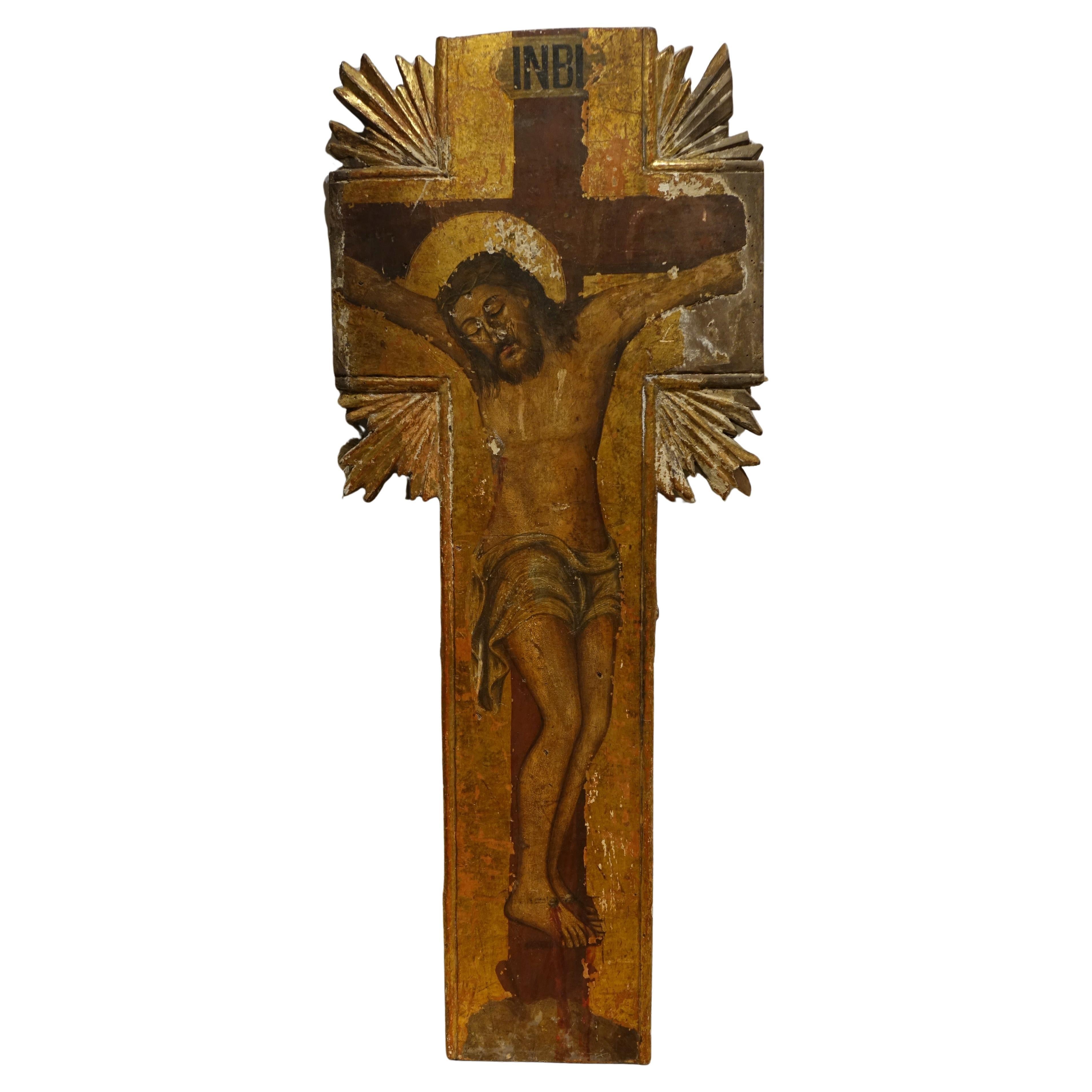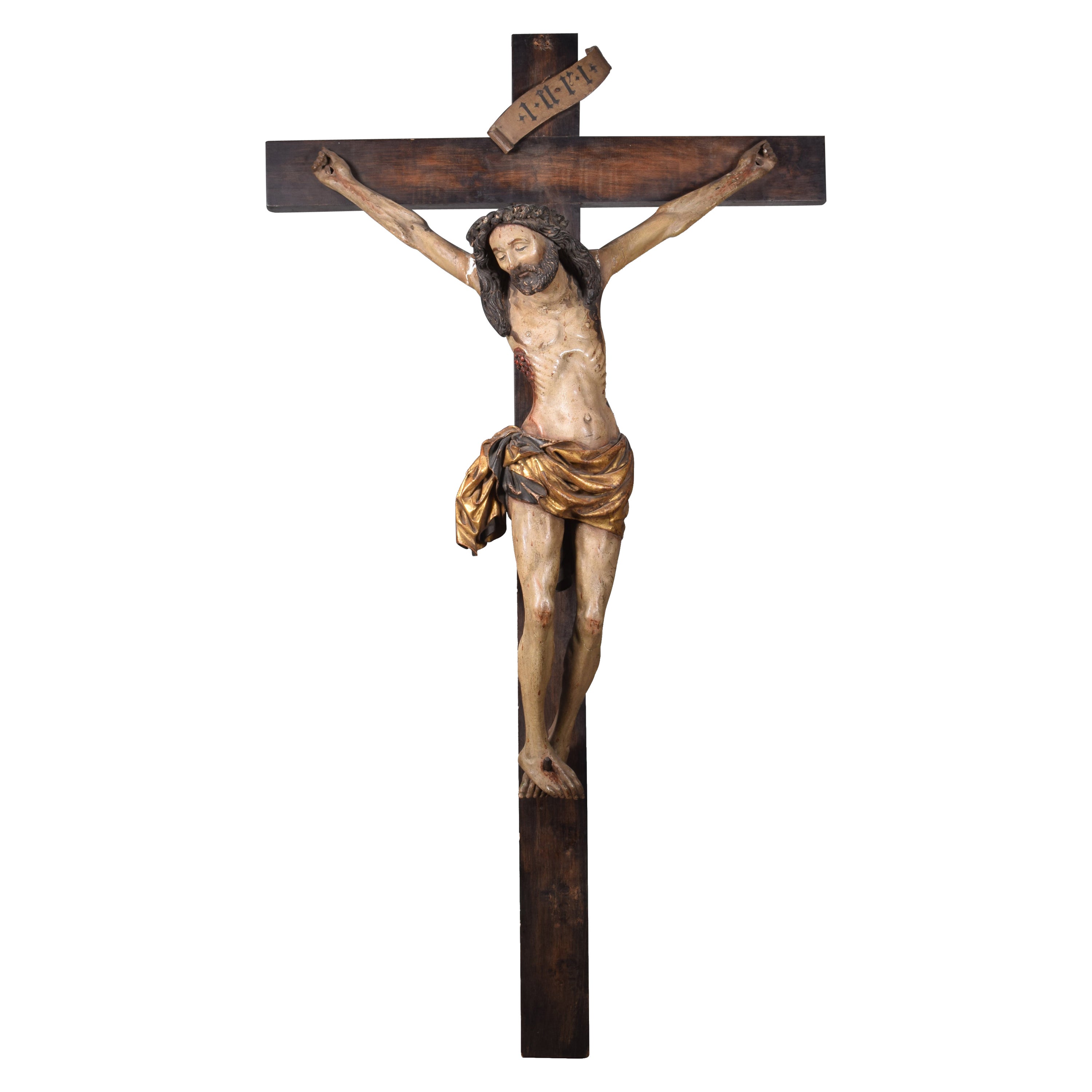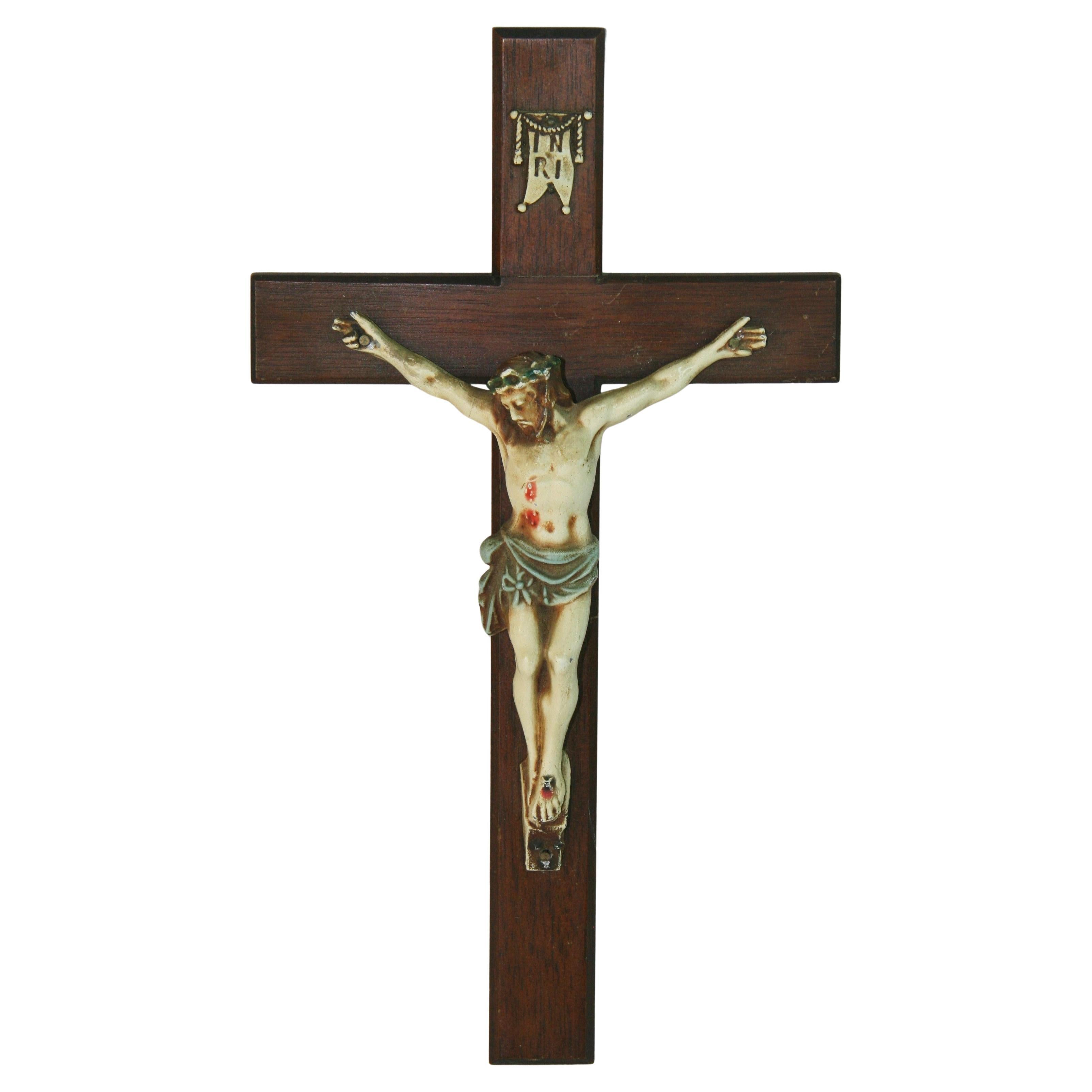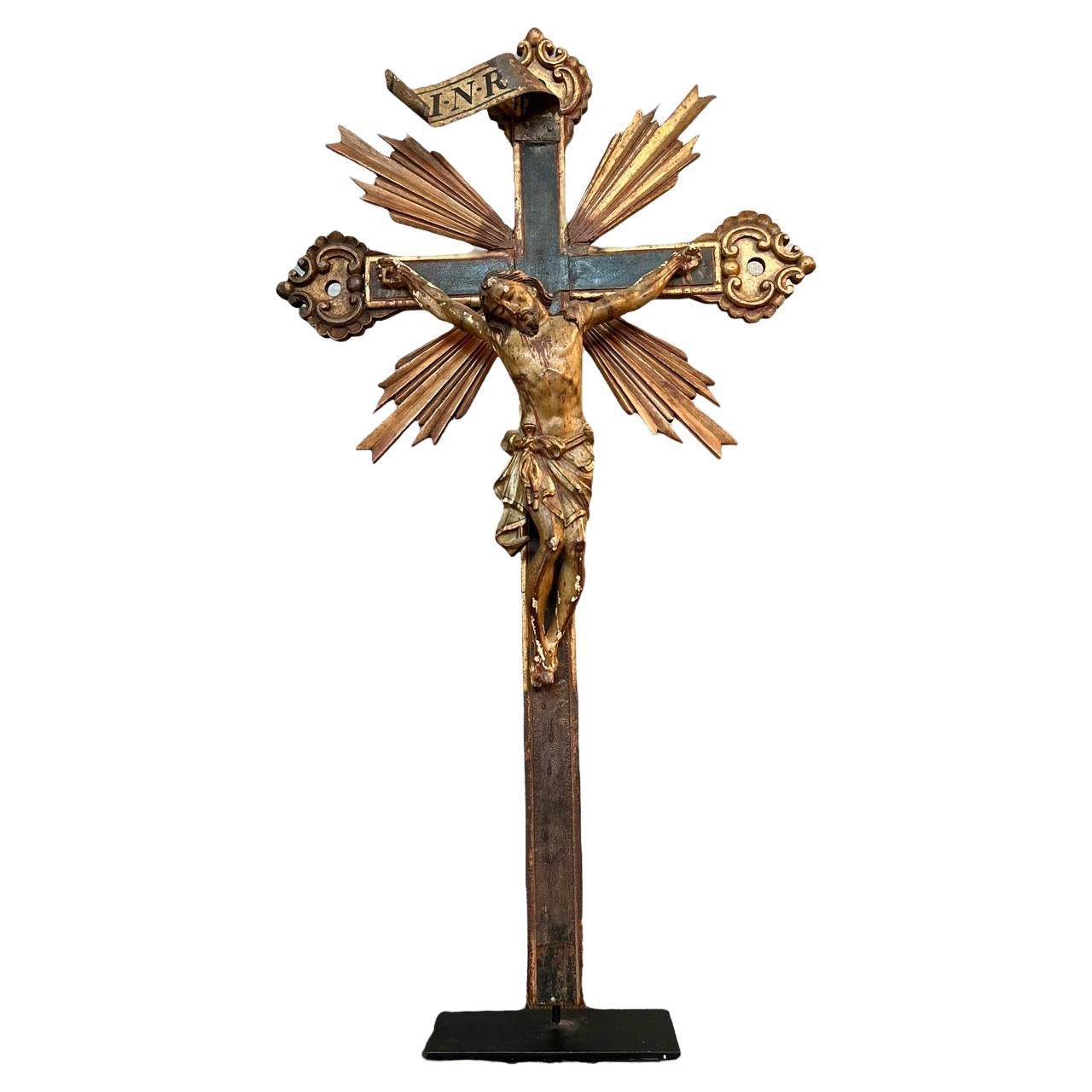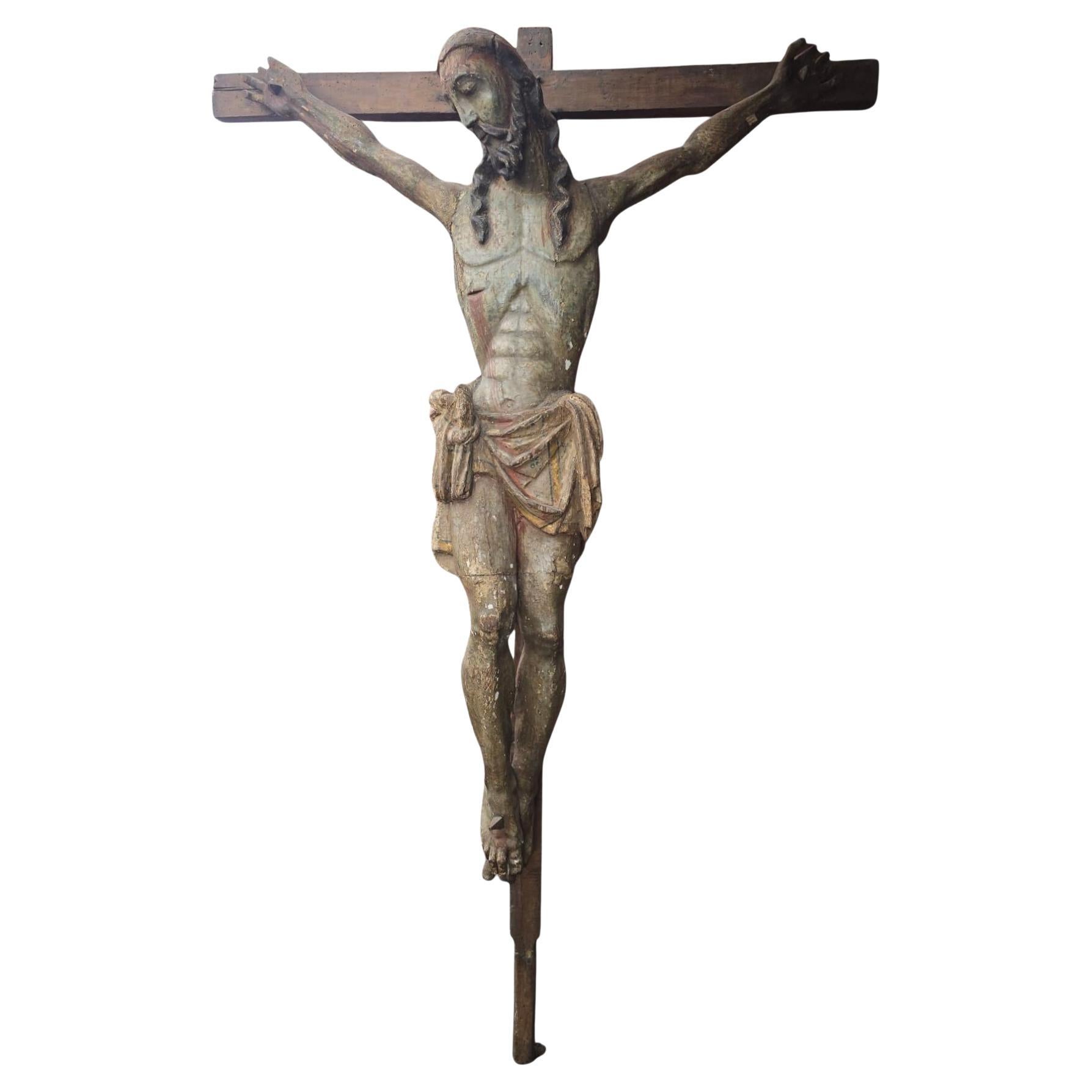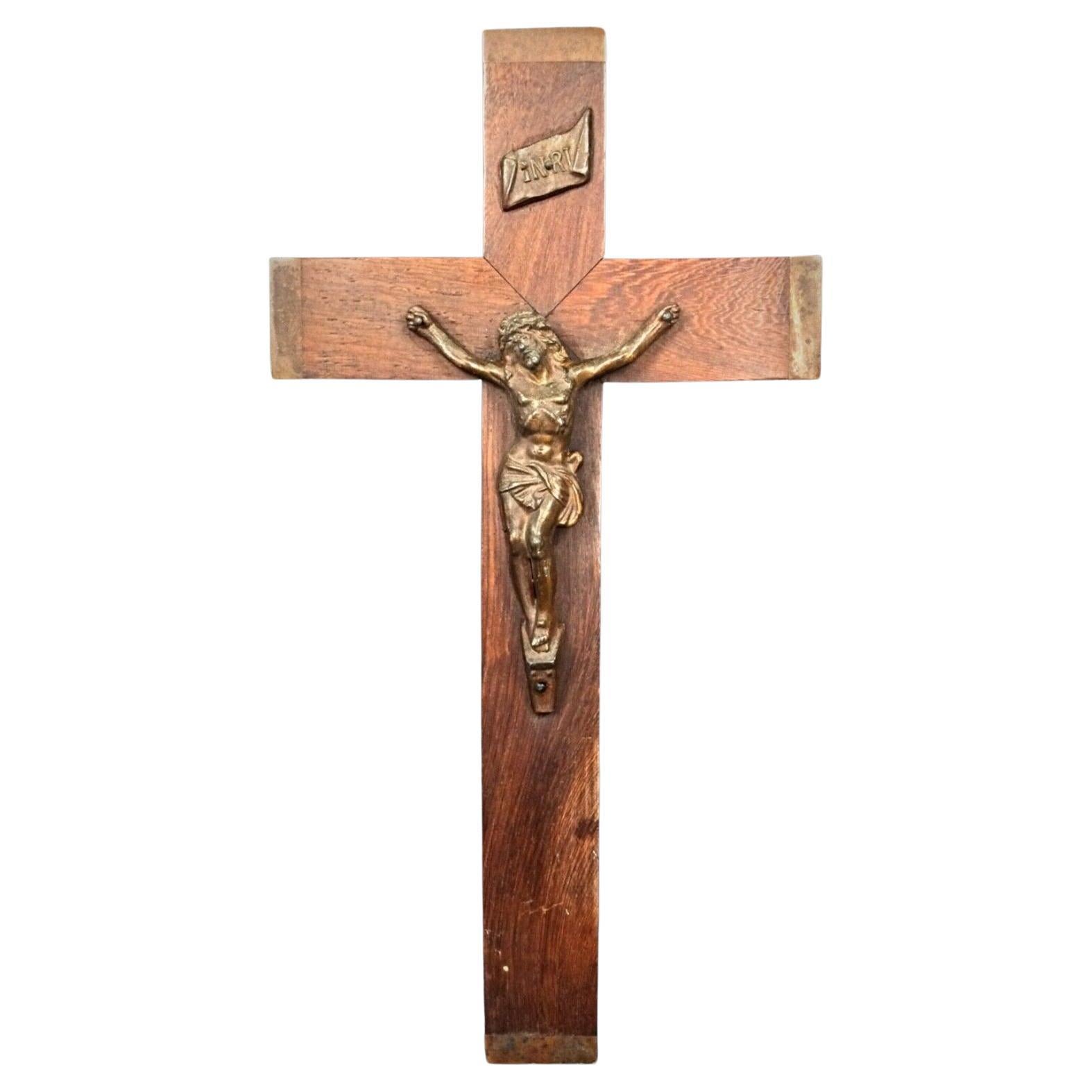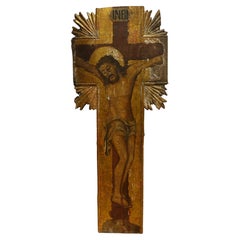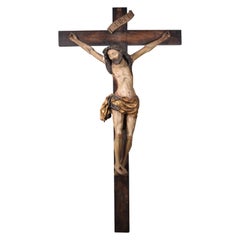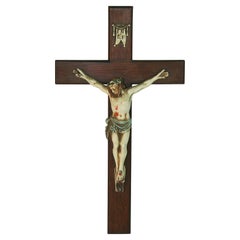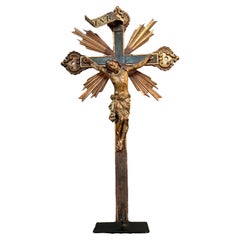Items Similar to Antique Wooden Crucified Wood Tempera Giotto
Video Loading
Want more images or videos?
Request additional images or videos from the seller
1 of 18
Antique Wooden Crucified Wood Tempera Giotto1800-1899
1800-1899
$24,278.70
$30,348.3820% Off
£17,909.28
£22,386.6020% Off
€20,280
€25,35020% Off
CA$33,639.36
CA$42,049.1920% Off
A$36,503.83
A$45,629.7920% Off
CHF 19,343.81
CHF 24,179.7720% Off
MX$447,701.70
MX$559,627.1220% Off
NOK 239,378.29
NOK 299,222.8720% Off
SEK 226,199.81
SEK 282,749.7720% Off
DKK 154,428.33
DKK 193,035.4120% Off
About the Item
Christ Crucified (Christus Patiens) with God the Father, the Virgin and St. John
In the manner of 14th century Tuscan painting
Tempera on panel
Height: 150 cm
Width: 99 cm
Performed non-invasive conservation restoration (photo of the work before intervention in detail)
We present this precious antique crucified Christ, with God the Father blessing on the cymatium, the grieving Madonna and St. John in the side terminations; the latter, weeping, are the figures mentioned in the gospels, present at the foot of the cross and who witnessed the sacrifice of Jesus, thus having an important value of testimony and participation.
The work, a tempera on panel, is executed in the manner of 14th-century Tuscan painting, following its standards of quality and style.
The first painted crosses, produced in Tuscany and Umbria in the 12th century, became the symbol of Christ's sacrifice and thus an emblem of Christianity. While in this first phase the typology of Christ was that of the Christus Triumphans, with the aspect triumphant over death, from the middle of the 13th century, with the preaching of Saint Francis of Assisi, who favoured the human aspect of Christ, the model of the Christus Pathiens was instead preferred.
A key work of this genre is Giotto's crucifix in Santa Maria Novella in Florence, not only for its quality, but also for the depth of its meanings and symbolic values, becoming a reference model for the painting of many followers.
Giotto renounces the beauty ennobled by the slender and geometrically perfect forms of the body (because they are divine) but improbable, in order to propose the body of an ordinary man, really nailed to the cross abandoned with all his weight physically visible.
The painter focuses on the realistic aspects of his condition, such as the colour of the flesh, the blood, the ribs pressing against the skin, the stretched tendons of the arms, the head leaning forward and the sense of exhaustion of the body.
As for the cross proposed here, we see a painting rendered according to the fourteenth-century canons introduced by Giotto: Christ has a recumbent head and great attention is given to the anatomical description of the body. It is made of shaped planks of soft wood; the painting is executed in tempera, but reveals a refined quality in the dosage of colours and chiaroscuro passages.
The halo, as well as the background of the terminal figures, is made with a gold background, also traditional. In our case, metal decorations are applied to the outline of the halo, a detail that does not belong to the Italian tradition, but seems to belong to the French Gothic taste.
ADDITIONAL INFORMATION:
Complete with certificate of authenticity and descriptive iconographic card.
We take care of and organise the transport of the purchased works, both for Italy and abroad, through professional and insured carriers.
Should you wish to see this or other works in person, we will be pleased to welcome you to our new gallery in Riva del Garda, Viale Giuseppe Canella 18. We are waiting for you!
Contact us for any information or to arrange a visit, we will be happy to answer you.
- Attributed to:In the manner of 14th century Tuscan painting
- Creation Year:1800-1899
- Dimensions:Height: 59.06 in (150 cm)Width: 38.98 in (99 cm)
- Medium:
- Movement & Style:
- Period:
- Condition:
- Gallery Location:Riva del Garda, IT
- Reference Number:1stDibs: LU988115625312
About the Seller
4.9
Platinum Seller
Premium sellers with a 4.7+ rating and 24-hour response times
Established in 2017
1stDibs seller since 2018
260 sales on 1stDibs
Typical response time: <1 hour
- ShippingRetrieving quote...Shipping from: Riva del Garda, Italy
- Return Policy
Authenticity Guarantee
In the unlikely event there’s an issue with an item’s authenticity, contact us within 1 year for a full refund. DetailsMoney-Back Guarantee
If your item is not as described, is damaged in transit, or does not arrive, contact us within 7 days for a full refund. Details24-Hour Cancellation
You have a 24-hour grace period in which to reconsider your purchase, with no questions asked.Vetted Professional Sellers
Our world-class sellers must adhere to strict standards for service and quality, maintaining the integrity of our listings.Price-Match Guarantee
If you find that a seller listed the same item for a lower price elsewhere, we’ll match it.Trusted Global Delivery
Our best-in-class carrier network provides specialized shipping options worldwide, including custom delivery.More From This Seller
View AllChrist Cross Religious Van Dyck 17th Century Paint Oil on canvas Old master
By Anthoon van Dyck (Antwerp 1599 - London 1641)
Located in Riva del Garda, IT
Anthoon van Dyck (Antwerp 1599 - London 1641) workshop
Christ Carrying the Cross - 17th century
Oil on canvas (120 x 94 cm - framed 140 x 112 cm).
This remarkable canvas, depic...
Category
17th Century Old Masters Paintings
Materials
Oil
$17,181 Sale Price
20% Off
Ecce Homo Coxie Paint 16/17th Century Paint Oil on table Old master Flemish Art
Located in Riva del Garda, IT
Circle of Michael Coxie (Malines, 1499 - Malines, 1592)
Ecce Homo with Pontius Pilate
Oil on panel
Flemish school 16th-17th century
112 x 81 cm - framed 121 x 90 cm.
The proposed p...
Category
16th Century Old Masters Paintings
Materials
Oil
$8,457 Sale Price
20% Off
Christ Column Religious Paint 16th Century Oil on table Lombard School
Located in Riva del Garda, IT
Lombard School of the 1500s
Christ at the Column
Oil on panel 24 x 21 cm - Framed 42 x 39 cm
The painting, rich in pathos and strong spirituality, depicts a moment from the P...
Category
16th Century Old Masters Paintings
Materials
Oil
$3,486 Sale Price
20% Off
Ecce Homo Christ Metsys 16th Century Paint Oil on table Flemish Old master
Located in Riva del Garda, IT
16th-century Flemish master
Circle of Quentin Metsys (Leuven, 1466 - Antwerp, 1530)
Ecce Homo
oil on panel
cm. 34 x 23
with frame 47 x 37 (not contemporary)
An important painting...
Category
16th Century Old Masters Paintings
Materials
Oil
$7,345 Sale Price
20% Off
Resurrection Christ Tiziano 16/17th Century paint Oil on canvas Old master Italy
By Tiziano Vecellio (Pieve di Cadore 1490 - Venice 1576)
Located in Riva del Garda, IT
The Resurrection of Christ
Follower of Tiziano Vecellio (Pieve di Cadore 1490 - Venice 1576)
Venetian school of the late 16th/early 17th century
Oil on canvas
108 x 78 cm. - Framed 129 x 99 cm.
This jewel of the Venetian school, a work executed between the 16th and 17th centuries by a Venetian artist, illustrates the episode of the Resurrection of Christ: as reported in the Gospel of Matthew (Matthew 28:1-7) the event is accompanied by an explosion of light and glow, with the figure of Christ rising into the sky.
Christ's face, serene and victorious, looks up towards the Light and the Infinite, in contrast to his majestic figure, here constructed with the appearance of a classical sculpture, contrasted by an intensely luminous background.
The Risen One firmly holds in His hand the banner (white with a red cross) of the Resurrection, also known as the flag of St. George, which iconographically represents His victory over death, while raising His right hand in a blessing act. With his feet he crushes a snake and a skull, a sign of Christ's triumph over sin and death.
The painting belongs to the Venetian school and presents clear reminiscences with the works of Titian Vecellio...
Category
17th Century Old Masters Paintings
Materials
Oil
$8,084 Sale Price
20% Off
Jesus Son Salvi Paint Oil on canvas Old master 17th Century Italian Religious
Located in Riva del Garda, IT
Ancient painting depicting Jesus with the Commissioner's son
(Alternative reading: St. Joseph with the Child, or the 'Paternity')
Giovan Battista Salvi known as "the Sassoferrato" (1609 - 1685) circle / follower
Oil painting on canvas
76 x 59 cm. -With frame in the shape of a small temple, not coeval 99 x 84 cm.
The interesting canvas that we are pleased to offer you recalls the iconographic model of classic paternity, which traditionally sees Saint Joseph holding the sleeping baby Jesus...
Category
17th Century Old Masters Paintings
Materials
Oil
$5,416 Sale Price
40% Off
You May Also Like
A Greek Crucifix painted in the Renaissance style.
Located in PARIS, FR
The crucifix painted in the Renaissance style.
Tempera on wood
Inscription: INBI
In the Eastern Church where Greek is the main liturgical language, one would find “INBI” for Ἰησοῦς ὁ...
Category
Antique Early 19th Century Greek Renaissance Paintings
Materials
Wood
Crucified Christ, Sorrowful Crucifix. Carved and polychrome wood.
Located in Madrid, ES
Crucified Christ, Sorrowful Crucifix. Carved and polychrome wood. Possibly southern German school, 15th century.
Polychrome and gilded wood carving showing Christ with the Crown of Thorns, on the Cross, already deceased (eyes closed), with the usual INRI phylactery on the upper crossbar of the Latin cross, three nails (note the crossed feet) and a short, golden and polychrome purity cloth or perizonium. It is known, in German, as “Gabelkreuz” or “Gabelkruzifix” (“Sorrowful Crucifix” in Spanish) to a type of Gothic Crucified Christ that is especially expressive (prioritizing external suffering over other aspects) and that, normally, presents the cross in a of Y or ypsilon (alluding to the Tree of Life), created, apparently, thanks to the influence of the mysticism of the late 13th and early 14th centuries (Saint Brigid...
Category
Antique 15th Century and Earlier European Renaissance Religious Items
Materials
Other
Antique Italian Wood and Handpainted Metal Crucifix
Located in Douglas Manor, NY
1842 Antique Itaian wood and painted metal crucifix
Category
Vintage 1940s Figurative Sculptures
Materials
Metal
17th Century Carved Wood and Polychromed of Crucified Jesus on the Cross
Located in North Miami, FL
Introducing a captivating 17th-century Italian carved wood and polychromed, gold-gilded crucifix depicting Jesus on the cross. This remarkable piece...
Category
Antique 17th Century Italian Baroque Figurative Sculptures
Materials
Metal
$11,165 Sale Price
30% Off
Large Christ on the Cross – 15th Century 180 CM
Located in Madrid, ES
Impressive 15th-century sculpture of Christ on the Cross, featuring a wooden crucifix and a polychrome Christ figure. The piece has been remarkably preserved, maintaining its origina...
Category
Antique 15th Century and Earlier Decorative Art
Materials
Fruitwood
Antique Wall Crucifix in Wood and Regule – Esoteric Religious Art - 2Y271
Located in Bordeaux, FR
Discover this exquisite antique wall crucifix crafted from wood and regule, embodying elements of esoteric religion. This unique piece is a striking addition to any collection of rel...
Category
Early 20th Century Unknown Antiquities
Materials
Metal
$140 Sale Price
55% Off
More Ways To Browse
Antique Tempera Painting
Antique Canon
Antique Canons
Paintings Of Eggs
Antique Wood Planks
Tuscan Painting
Painting In Egg Tempera
Francis Assisi
Wooden Eggs
Painting 14th Century
14th Century Medieval
Christ Of Saint John Of The Cross
15th Century Wooden
Antique Wooden Egg
Giotto Painting
Santa Maria Novella
18th Century Portrait Of
Silhouette Art
